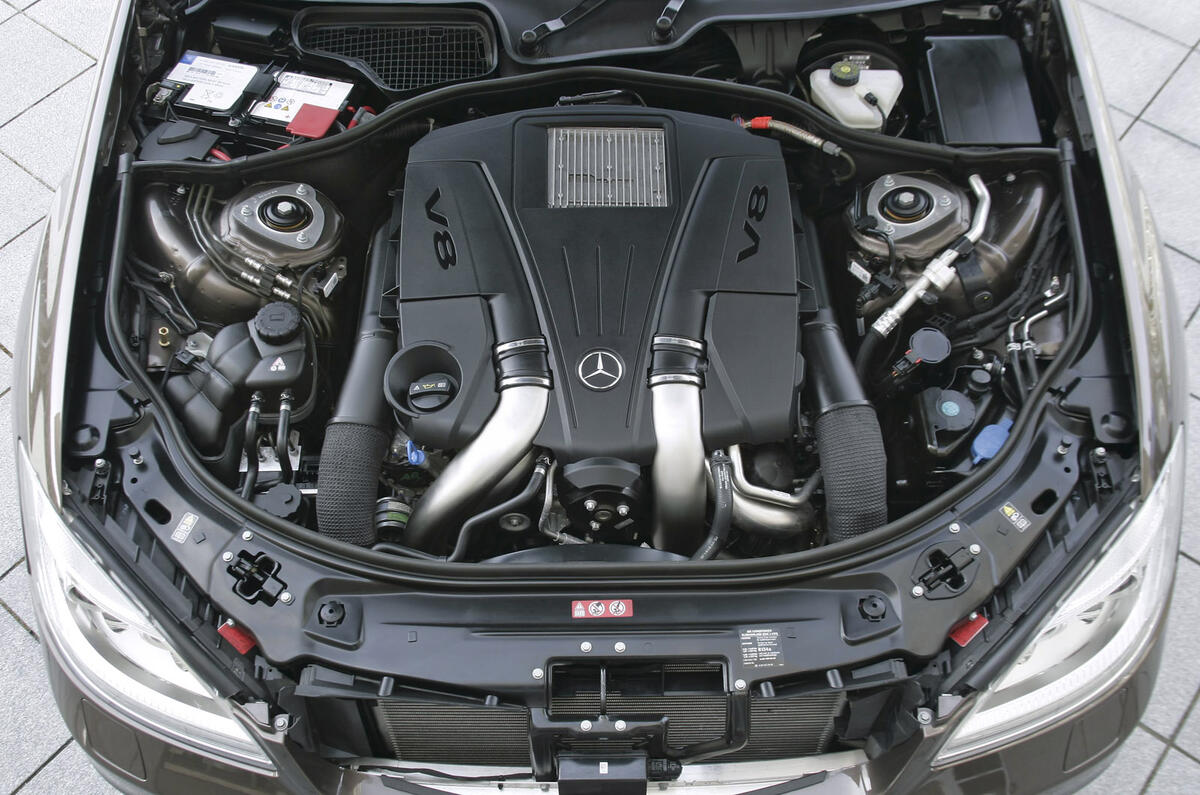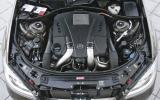A new range of more powerful, torquier and more frugal V6 and V8 petrol engines will be introduced across the Mercedes range from autumn this year.
The headline changes for the V6 are a new narrow-angle block and for the V8 a reduction in capacity mated to twin-turbo induction.
See pics of Mercedes' new V6 and V8 engines
Both vee-engines also get third-generation direct injection with piezo-electric injectors, revised combustion, multi-spark ignition and low-friction ancillaries to cut fuel consumption by up to 24 per cent.
Major changes are wrought to the V8, which gets a new, smaller-capacity block of 4.6 litres, reduced by 15 per cent from the 5.4 litres of its predecessor, together with the addition of twin turbochargers, arranged with one blower for each bank of cylinders.
Peak power goes up to 429bhp, a 12 per increase, while torque is boosted 32 per cent to a whopping 516lb ft.
“The driver experiences the same pleasant and effortless performance from the new V8 as that delivered by a mighty, naturally aspirated 7.0-litre engine,” says Mercedes.
In the CL500 - the launch model this autumn - fuel economy improves by 22 per cent to 29.7mpg, with CO2 dropping by an equally impressive percentage to 224g/km.
The addition of turbos also spread the V8’s torque delivery across a wide rev range, Mercedes claiming that the “driver perceives no turbo lag” and that “an outstanding 442lb ft is available between 1600 and 4750rpm”.
The new V6 will feature in the S350 from the autumn and the CL350 from the winter. A significant change is a new block, which moves from a 90-degree vee angle to a more ideal 60-degree vee, which reduces vibration and allows Merc to drop the balancer shaft, cutting weight.
Still naturally aspirated, the 3499cc V6 nevertheless matches power and torque increases with better fuel economy and lower emissions.
Stop-start technology, which cuts consumption in traffic, is employed for the first time on a multi-cylinder Merc engine.
Peak output rises to 301bhp, up from 268hp, while torque rises to 272lb ft from 258lb ft. Merc says this torque peak is available from 3500rpm up to the 5250rpm red line.
But the major improvements are to fuel economy and CO2 output. In the bulky S350, the new V6 is claimed to be capable of 37.1mpg - a 24 per cent improvement - and 177g/km.














Join the debate
Add your comment
Re: Merc's new V6 and V8 engines
Lol you're right, my mistake...the 750i has 402bhp and 443lb/ft of torque (I read the wrong column whilst writing the figures for the 750). And yes, the turbo and supercharger are probably why the BMW and Audi respectively have higher torque figures...
So that means the 'list' now reads as follows:
6-cylinders:
(Power / Torque/ Average MPG / grams of CO2/km)
BMW 535i: 302bhp / 295lb/ft / 33.2mpg / 199g
Audi A6 3.0 V6 TFSI Quattro: 286 bhp / 310 lb/ft / 30.1mpg/ 219g
Mercedes S350 V6: 301bhp / 272lb/ft / 37.1mpg / 177g
8-cyliners:
BMW 750i: 402bhp / 443lb/ft / 24.8mpg / 266g
Audi A8 4.2 FSi Quattro: 366bhp/ 328lb/ft / 29.7mpg/ 219g
Mercedes CL500: 429bhp / 516lb/ft / 29.7mpg / 224g
Which means that, all in all, the new Mercedes engines have a larger advantage than I originally thought ;)
Re: Merc's new V6 and V8 engines
750 is 402BHP and 442LB FT, and the 535 is a turbo, whilst the A6 3.0 TFSI is S/C
that explains the torque
Re: Merc's new V6 and V8 engines
I thought we were talking about the new Merc engines; the new V8's displacement has been reduced to 4.6 litres, so now it's actually smaller than the BMW's but as I said it manages to deliver similar power but much more torque.
Audi are known to be traditionally nose heavy, but the E-Class has a weight distribution of 51/49 (f/r)...you can't improve much on that. Plus, according to reviews I've seen, the E-Class is quite grippy and handles rather well considering its superior comfort: naturally, it's not as sporty as the BMW but that wasn't the main focus when designing the E-Class, since Mercedes place comfort higher than sportiness. BMW do it the other way around...which is no bad thing, or else all the cars would be virtually the same ;)
So the conclusion is that cars like these are generally all rather good, but it depends on your own personal taste when it comes to deciding which one is best for you.